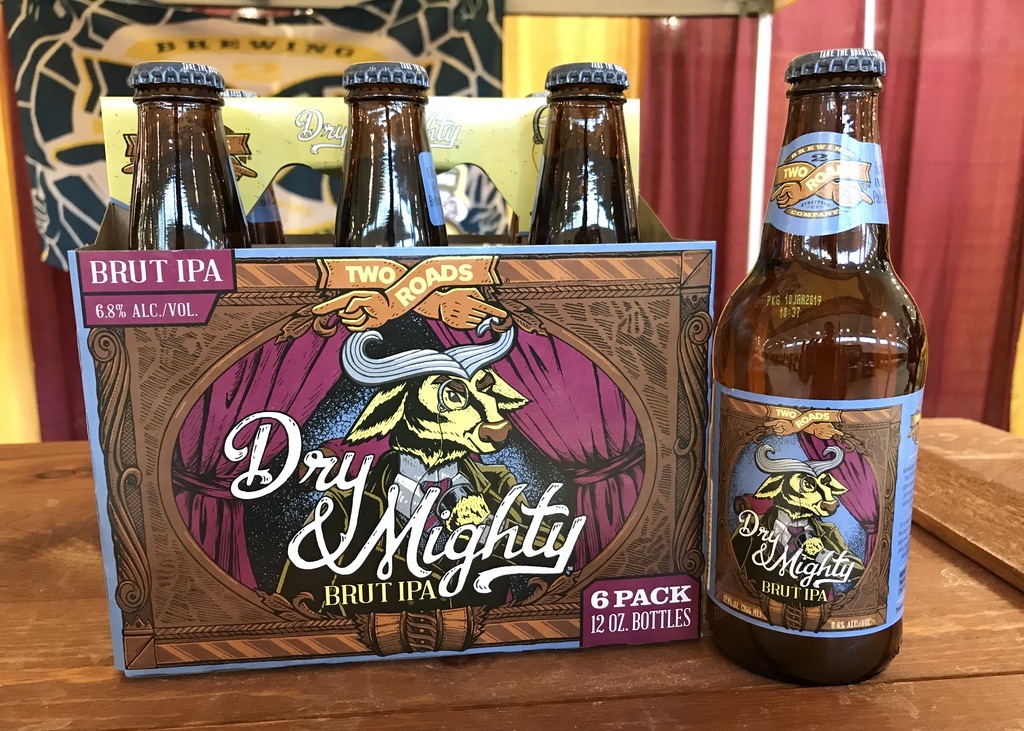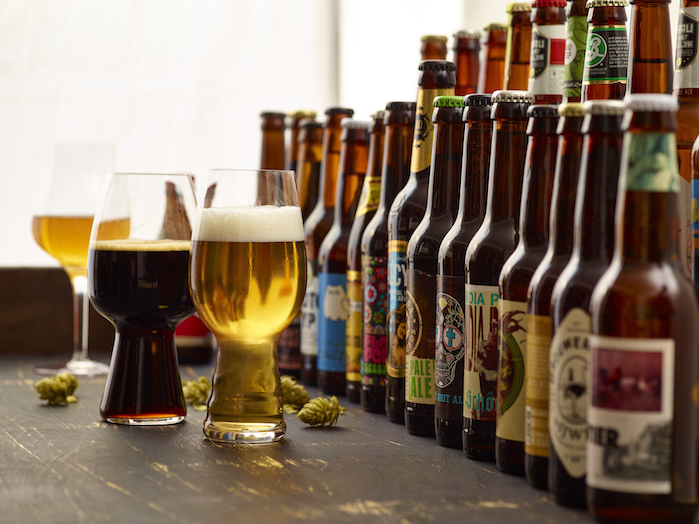Craft beer seems to be at a crossroads.
Industry growth has slowed (although there still is growth). At the same time, the number of U.S. breweries continues to reach new records. Added up, that’s not an ideal equation.
Will the outcome be another bubble? But what’s missing from the equation this time, unlike when a craft bubble burst in the late ‘90s, is questions of quality. Overall the industry has never had so many top-notch beers. Brewers are excelling at their craft: they make, ship and pour a wide variety of products that do not disappoint.
The winner here is drinkers. We’re spoiled with a diverse abundance of high-quality beer. Exploring through it all has become its own consumer lifestyle. As palates expand, improve and change, brewers have reacted with new takes on old styles. While many flavor trends that defined the industry in years past will remain strong in 2019, newer alternatives have also emerged and taken hold.
But all those world-class brews may not be enough if the industry has simply reached its saturation point. Is there still room for growth? Where are the profitable margins? How can breweries hold the attention of the increasingly fickle consumer? These are questions that will define craft beer in 2019, along with these other key trends:
1) Craft Beer Saturation?
Craft beer consumers who walk into retail stores cannot be blamed for feeling overwhelmed. The sheer number of breweries and SKUs is daunting. Even the most knowledgeable craft fans may no longer know half the brands available.
Behind this SKU surge is the brewery boom: more than 7,000 now operate in the U.S. And active brewery permits with the TTB now total more than 9,000. That’s an indicator of the industry’s size two years out, says Bart Watson, chief economist, Brewers Association.

At the same time, the explosive growth enjoyed by the category in the earlier 2010s has slowed to single-digit gains. The industry only grew around 5% in 2018, down from the double-digit increases of years before.
Altogether it’s more difficult now for breweries (and retailers) to capture consumer attention. Especially as more drinkers turn to spirits and wine. So what’s the strategy for that in 2019? There seems to be two prevailing modes of thought.
“Competition is becoming more concentrated. More than ever, craft breweries will need to be hyper focused on consumer trends and look to innovate on these insights,” says Ben Widseth, VP of marketing for Green Flash Brewing Co. in San Diego, CA.
Which is to say that we will see even more creative takes on standard beer styles in 2019. Brewers will fight for consumers’ eyeballs with unique brews that stand out on shelves.
The alternative strategy in 2019 is the opposite. Some craft brewers believe it’s better to pull back from crazier releases and instead focus on core brands.
“The number one trend I see is that there will continue to be too many choices. Consumers are more confused than ever with the amount of options — some that are over-the-top — that eventually people will go back to what they know,” says Jack Hendler, co-owner and brewer at Jack’s Abby, in Framingham, Mass.
Which is why whatever’s most local will likely continue to enjoy strong loyalty among consumers.
“Whenever we are asked, ‘Are there too many craft breweries?’ I always ask, ‘Are there too many BBQ joints in Kansas City?’” says Natalie Gershon, VP of marketing for Boulevard Brewing Co. in Kansas City, MO. “While the market may have slowed a bit, there is still a ton of opportunity for breweries to carve out spots where they can become the neighborhood bar. There’s never been a time where folks have lived closer to so many brewery options.”
2) Craft Beer Goes Macro
The terms “macro” and “craft beer” are usually at odds. But maybe that’s part of the problem for craft beer right now. What if craft took a page out of domestic beer and focused more on key brands? That’s the future envision by Mike Stevens, co-founder of Founders Brewery in Grand Rapid, MI.
“For a while there you’d have four different seasonals, plus limited-edition add-ons, and then next thing you know you were up to 28 beers in your portfolio, and you’d think, ‘Whoa, what did we just do?’” he says. “And of course, those large rotations of different beers helped captivate the craft beer audience we have now. But now we need to bring that SKU number down and focus on the core brands.”
“I think we’re starting to see hints of that already, of consumers starting to go the other way,” he adds.
Stevens imagines larger-scale breweries like Founders making fewer seasonals and one-offs. This is all part of his vision for the category that moves beyond traditional craft drinkers.
“You look at the beer industry as a whole, we’re all fighting over that same 15% market share, and not that 85%,” he says. To achieve broader appeal among mainstream consumers, “We need to focus on a narrowing handful of brands, not 28 brands, and spending money supporting those core brands,” Stevens says. “We need to free this thing up a bit so that the momentum can get back to the positive numbers.

One potential issue with this strategy it that modern consumers are less brand loyal than ever. They experiment across a wide variety of brands, styles and categories. Retailers in the recent past have reported customers who never drink the same beer twice: they only want what’s new to them.
That attitude has since changed slightly. While people may no longer have one go-to brand, they do seem to settle now “on a consideration set of about a half-dozen go-to beers, which they’ll fall back on when they’re not trying something new,” says Scott Ungermann, production director at Anchor Brewing in San Fran, CA. The key for brands is getting into that consideration set.
And for the beer industry overall, the best opportunity for growth is likely reversing the trend of losing drinkers to competing alcohol categories.
“Winning over the ‘macro’ drinkers is a component of increasing craft beer market share; however, the most sustainable growth plan will be to source new drinkers from other alcoholic categories, such as wine and spirits, so the total beer industry is growing which is best for all brewers,” says Widseth of Green Flash.
And there are other potential drawbacks to the idea of macro craft beer.
“I’m worried that too many craft breweries are now making beer not with a focus on flavor but affordability,” Dogfish Head Founder and President Sam Calagione told us last April. “The problem with that is the only entities with the scale to sustain that business model are multinational conglomerates.”
“I’m hoping that consumers will decide that craft beer pricing deserves to be stratified,” Calagione continues. “That’s why I love to see little hot-shit breweries like Trillium find success with $17 4-packs. That’s good for the whole industry.”
Yet Stevens of Founders believes craft can and should play in the broader market.
“We must professionalize our branding efforts,” he says. “Think about it: Nobody has really built a brand in craft beer like Amazon, Apple or Coca-Cola. Someone in craft right now could be the next person to build America’s next greatest brewery. There’s opportunity and a need to fill.”
3) Brut IPAs Vs. New England IPAs
New England IPAs, or hazy/unfiltered IPAs, exploded out of Vermont several years back and then swept across the country. The word “hazy” has since appeared on the labels of so many beers, many of them not hazy at all, that the term has almost lost meaning.
The west coast has brewed up the perfect counter to this east-coast phenomena. Drinkers sick of all those heavy, juicy NEIPA malt bombs will enjoy the newest IPA trend: Brut IPAs.
These beers are made with brut Champagne yeast. The wine flavor comes through: Brut IPAs are crisp, balanced, light-bodied, dry, with light fruit flavors and floral hop aromas. In other words, the opposite of their hazy cousins.
Reps of the Colorado-based brewery New Belgium, at a recent industry expo, described Brut IPAs as “an outcry against New England IPAs. This is back to the basics. There’s no end in sight to New England IPAs, but the pushback has begun.”

4) IPAs Remain King
The Brut IPA pushback against NEIPAs can also be seen as another sign that the IPA category remains the top driver of craft sales. The category has become so diverse that there is now an IPA for every kind of drinker. Reports of “IPA fatigue” among consumers do not appear to be true.
“The IPA segment has slowed in growth, yet it still represents more than half the volume of the craft beer market, so it’s hard to say that we’re nearing the end of the craze,” says Widseth of Green Flash. “Instead, you see IPA’s transforming into its own sub-category with hazy, low-ABV, high-ABV, and low-calorie options. This sort of innovation within the IPA space should continue to keep the style dominant.”
5) Low-Cal Craft Beers
The nutritional movement that’s defined food for years now has worked its way into the alcohol world — including craft beer. “Nutritional” and “beer” are not words that go together easily. But consumers care more now than ever about what goes into their bodies, so that if they can skim calories out of their beer consumption, they will.
That’s why so many breweries have recently released low-cal options. By nature these are lower-ABV as well. Lagunitas just came out with DayTime IPA, a 4%-ABV, 98-calorie beer. New Belgium’s Mural, a Mexical-style U.S. craft beer, is only 110 calories, with 0 grams of sugar.

The demo for these beers is active-lifestyle consumers who work out and eat/drink smart. These are people that Michelob Ultra has tapped into with extraordinary success, making that brand the only macro lager that’s growing explosively. Accordingly, look for craft beers to fight for these active-lifestyle consumers with branding that plays into their habits. An example of this is Harpoon’s new Rec. League Hazy IPA, 3.8% ABV and 120 calories, with a name that references gym leagues.
6) Craft Lagers Ready for Growth
Craft lagers are like the craft gin or rum categories — people keep saying that massive growth is around the corner, only it hasn’t happened yet.
But there’s plenty opportunity for lagers in 2019. Brewers agree: economics are on their side.
“Not only will consumers want more lagers, breweries will start making more,” says Hendler of Jack’s Abby, which specializes in lagers. “Because of the state of the beer industry and the economy, as breweries slow down a bit, it frees up more capacity, allowing them to devote more time and brew more lagers.”

Lagers also represent a lower price point than IPAs, stouts or sours. Those three styles are commonly sold in premium-priced 4-packs, 375-ml. bottles, or bombers. Consumers who want more bang for their buck can pick up a cheaper 6-pack of craft pilsner.
“As craft beer becomes more accessible both from an availability and price standpoint, the craft lager will be a gateway for these consumers into the industry,” says Widseth of Green Flash. “Additionally, as seen by the growth of session craft beers, loyal craft drinkers are turning to craft lagers as a change of pace from their higher-ABV and heavily hopped options.”
And sometimes, people just want good simple beer.
“As craft beer looks to reach new drinkers, it’s the approachable styles that are going to get folks in the door,” says Gershon of Boulevard Brewing. “While crazy flavored beers are still going to continue to generate buzz, ‘beer-flavored beer’ will always have a seat at the table.”
7) Approachable Sours Remain Hot

The point above about low-cal, low-ABV beers also ties into the growing trend of session sours. While craft beer aficionados will always love their 375-ml. bottles of barrel-aged apricot saison, the growth in sours is led by the likes of Dogfish Head SeaQuench Ale: light-drinking sours.
Gershon believes this is part of a broader trend of consumers seeking easy variety.
“I think this speaks more to the explorative palates of consumers,” she says. “Recent studies show that two-thirds of Millennials are drinking three-plus types of alcohol regularly vs. half of the Boomer population that drink one type. The crossover between wine, beer, spirits, ciders and seltzers are creating adventurous consumers, who want a variety of flavor profiles at their convenience. Low-ABV, session sours are a great example of that and personally, I am in on this trend.”
Agreeing with her is Widseth of Green Flash.
“As the craft beer drinker base continues to expand and their palates evolve, consumers are seeking alternative styles like, sour beers,” Widseth says. “Regarding the low-ABV inclusion, this is a trend that should permeate across the craft beer landscape as drinkers look for lower alcohol craft options.”
8) Taprooms Takeover
As producers and SKUs increase, and distribution becomes tougher to obtain, newer craft breweries have increasingly turned towards taprooms to support their bottom lines. Many states have changed their laws in recent years to allow these direct-to-consumer sales.
“Obviously there is a lot of room for bars in America, which is essentially what these are,” says Stevens of Founders. “They’re a great way to introduce people to craft beer and work on their palates. We’re definitely going to see more taprooms because they’re an easier road to go, where you break even much quicker.”
Which has caused issues for actual bars and restaurants, as they lose guests to taprooms. Retailers also believe that the taproom wave has washed away some business for off-premise, because consumers now prefer those beers fresh from the source rather than off the shelf. (Whether that’s accurate is a topic of debate.)
Taprooms and breweries have also become a way to cut out distributors. Many producers now sell packaged products directly to visitors. “It’s awesome margins,” says Stevens. Lines of customers out the door at places like Tree House certainly speak to that.
But taprooms are more than just reliable money-makers. They have also become an invaluable source of consumer feedback.
“Our tap room is a place for people to taste existing beers and also a place of experimentation for us,” says Ungermann at Achor. “We can immediately taste test new beers with consumers and get instant feedback. We tested pilot batches of an IPA that developed into our Baykeeper IPA before recently launching that.”

What’s Next for Craft Beer?
Add up all the above and you have an increasingly diverse craft beer category of high-quality products, but with infighting for consumer attention while the category fends off wine and spirits. Yet there’s also room for growth, especially in hyper-local and national-macro. Craft beer still has opportunities for growth that extend far into the future.
“You have to remember, we now have two whole generations of consumers who are not resonating with the domestic brands,” says Stevens of Founders. “That means that the beer brands that are out there 10-to-20 years from now will be significantly different. In lies the opportunity.”
Kyle Swartz is editor of Beverage Dynamics magazine. Reach him at kswartz@epgmediallc.com or on Twitter @kswartzz or Instagram @cheers_magazine. Read his recent piece Lagunitas Now Brews Newcastle Brown Ale — How’s it Taste?





I disagree. I think micro breweries an craft beer is a fad an won’t be around in 10 years. Sure the bar or beer establishment might still be there but who wants to buy a beer for $7-8 bucks when most of them taste like shit? Your overwhelmind with the amount of selections an the cunt waiter looks at you like your suppose to know exactly which beer you like and why you can’t make up your mind about? Then you go to the next bar an have to start all over again trying to find a beer you like the taste of? So what do most people do jus as you said in your article, they go back to what they know instead of trying to pin the tail on the donkey in picking one that you like the taste of? What happened to the beer Red Dog or Bud Ice, Michelob, and I’m not talking about that shitty ultra Michelob. What do I know …
weak comment… the “cunt waiter” knows how to steer you in the right direction… all you need to do is ask questions and be open minded… which I gather you aren’t.
Nice content! Thanks for the heads up!
[…] Covid-19.Before the pandemic, craft enjoyed rapid growth, fueled by consumer experimentation and a breakout in the taproom model. Then Covid closed on-premise.Panicking, consumers stocked up on familiar brands. No longer […]